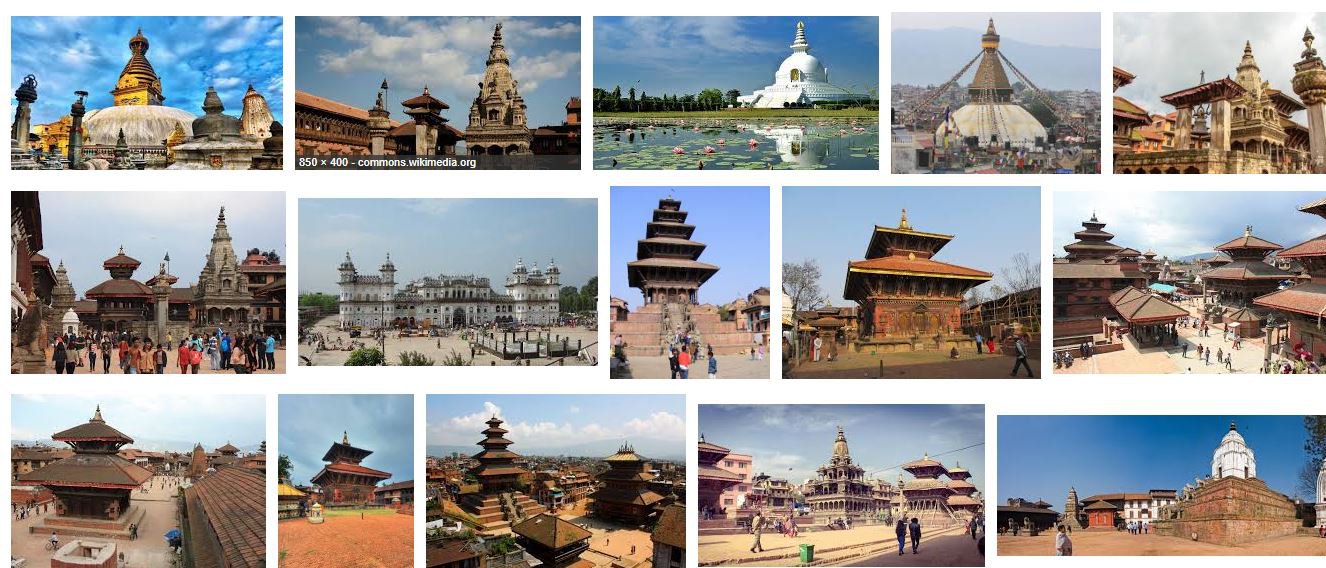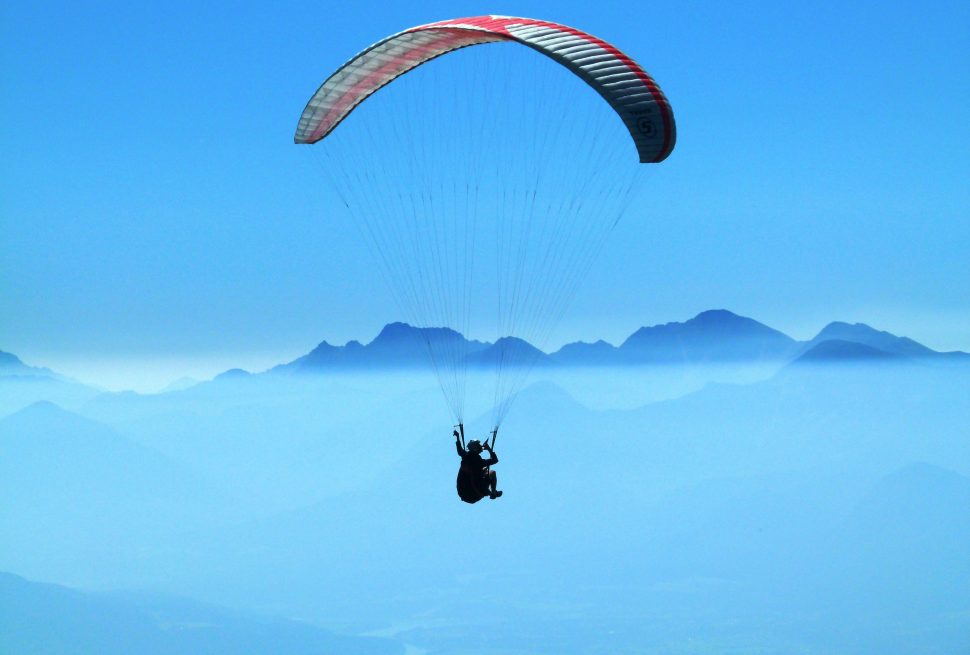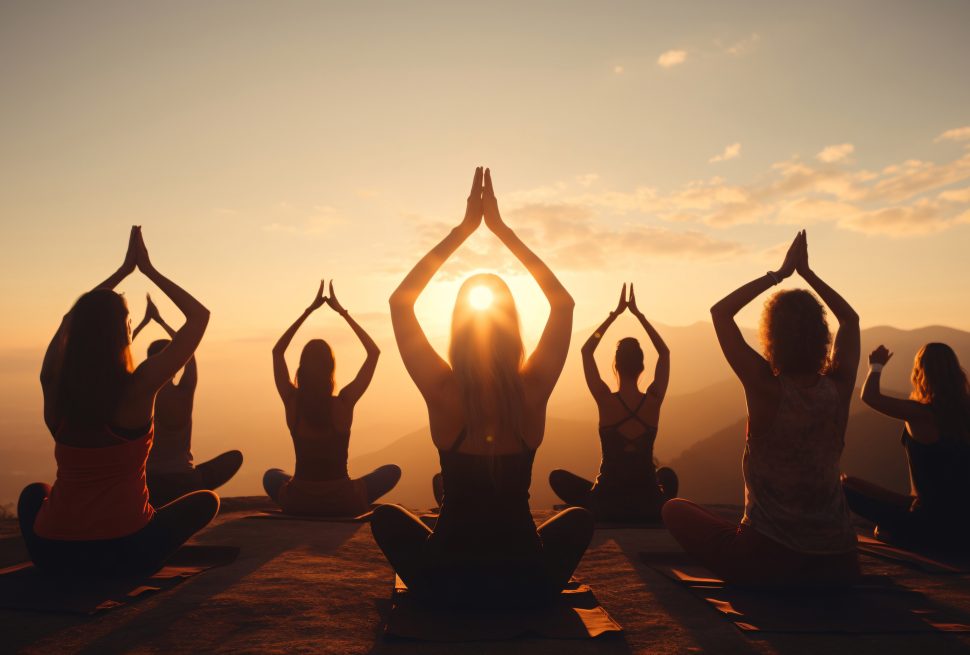Nepal, a land where history and nature converge in breathtaking harmony, boasts the UNESCO World Heritage Sites to visit in Nepal that captivate the soul and ignite the imagination. Embark on a journey through the Kathmandu Valley, where ancient temples and palaces like Swayambhunath Stupa, Boudhanath Stupa, and the vibrant Durbar Squares of Patan and Bhaktapur echo tales of bygone eras. Venture into the heart of Chitwan National Park, where the untamed beauty of the jungle offers encounters with majestic one-horned rhinoceroses and elusive Bengal tigers. write this much paragraph in simple words as well
Stand in awe at the foot of Mount Everest within Sagarmatha National Park, where the world’s highest peak dominates the horizon. Lastly, visit Lumbini, the sacred birthplace of Buddha, where serene monasteries and sacred gardens offer a profound spiritual experience. Each of these UNESCO treasures is a gateway to Nepal’s rich cultural tapestry and natural splendor, making them indispensable stops for any traveler seeking to uncover the country’s deepest wonders.
Essential Information on Nepal’s Top 1O UNESCO World Heritage Sites
| List of Heritage Sites | Established Date | Listed in UNESCO | Location |
| Kathmandu Durbar Square | Ancient Period | 1979 | Kathmandu Valley |
| Bhaktapur Durbar Square | 12th Century | 1979 | Bhaktapur, Kathmandu Valley |
| Patan Durbar Square | 3rd Century BC | 1979 | Lalitpur, Kathmandu Valley |
| Changu Narayan Temple | 4th Century AD | 1979 | Bhaktapur, Kathmandu Valley |
| Swayambhunath Stupa | 5th Century | 1979 | Kathmandu Valley |
| Boudhanath Stupa | 14th Century | 1979 | Kathmandu Valley |
| Pashupatinath Temple | 5th century AD | 1979 | Kathmandu Valley |
| Lumbini | 3rd Century BC | 1997 | Rupandehi District |
| Chitwan National Park | 1973 | 1984 | Chitwan, Southern |
| Sagarmatha National Park | 1976 | 1979 | Solukhumbu District |
Below are descriptions of the UNESCO World Heritage Sites to Visit in Nepal.
Kathmandu Durbar Square: A Historical Jewel of Kathmandu
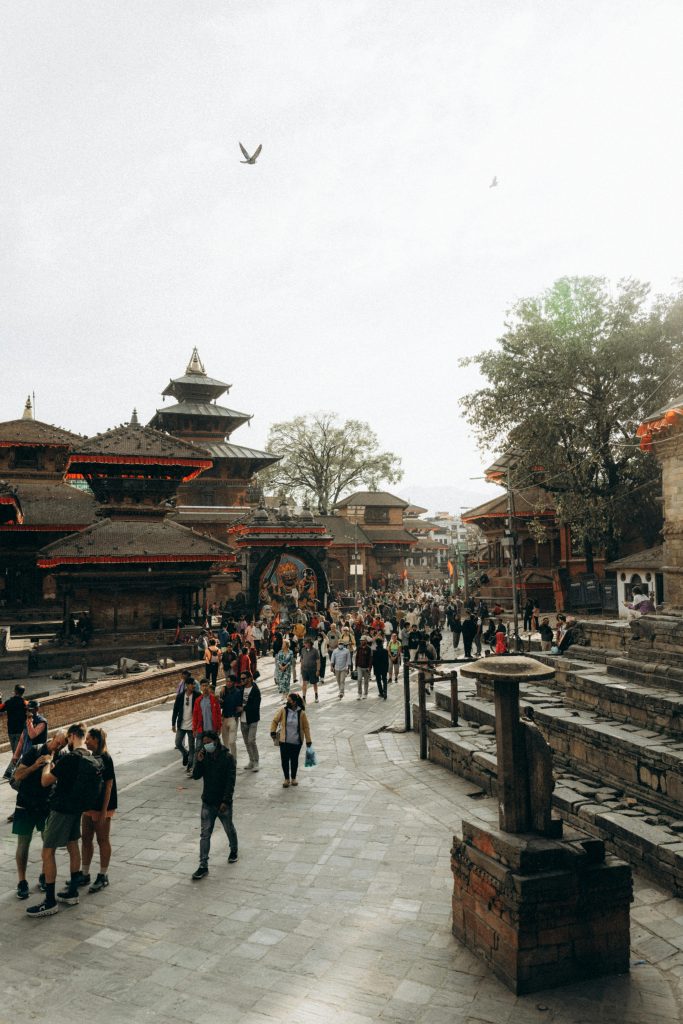
Overview
Kathmandu Durbar Square, also known as Hanuman Dhoka or Basantapur Durbar Square, is a UNESCO World Heritage Site and the historical heart of Kathmandu Valley. It offers an open-air museum experience with its collection of grand temples, pagodas, and palaces. The square is a vibrant cultural hub and home to the Kumari Ghar, the residence of Kathmandu’s living goddess.
Historical Significance
Originally built during the reign of the Malla kings, the square was the royal palace complex and a center of political and cultural life in medieval Kathmandu. The term “Hanuman Dhoka” is derived from a large statue of Hanuman, the monkey deity, which once stood at the entrance of the palace. Today, the square is a focal point for both local festivities and tourist exploration, embodying the grandeur of Nepal’s past
Key Highlights
– Kumari Ghar: The residence of Kumari, Kathmandu’s living goddess, Kumari Ghar is an architectural gem with its intricately carved wooden windows and decorative elements. The Kumari, a young girl selected based on strict criteria from the Newar community, is revered as the physical embodiment of the goddess Taleju. Visitors can view the Kumari from the balcony of this traditional Newari palace.
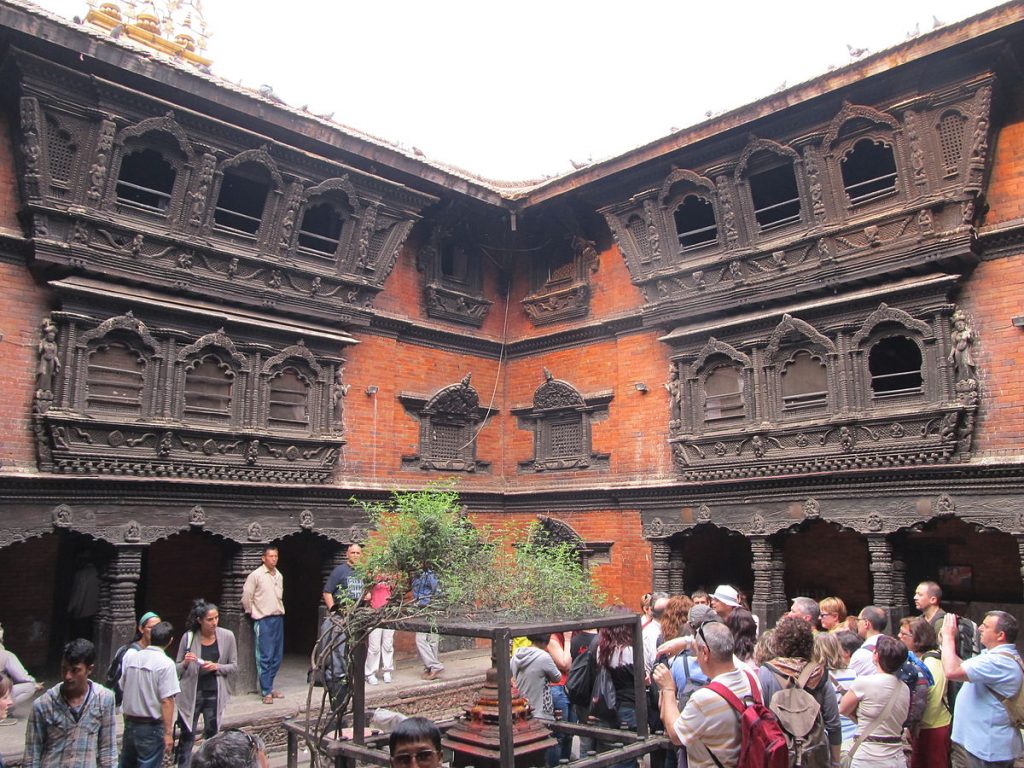
– Hanuman Dhoka Palace Museum: Located within the former royal palace, this museum offers a deep dive into Nepal’s regal history. Exhibits include ancient royal artifacts, traditional weapons, and historical manuscripts. The museum provides insights into the Malla kings’ lives, their governance, and the architectural splendor of their era.
– Taleju Temple: Dedicated to the goddess Taleju, this temple is renowned for its grand architecture and elaborate carvings. It was built by King Mahendra Malla and is considered one of the most significant temples in Kathmandu. The temple’s intricate woodwork and stone sculptures reflect the artistic brilliance of Newar craftsmanship.
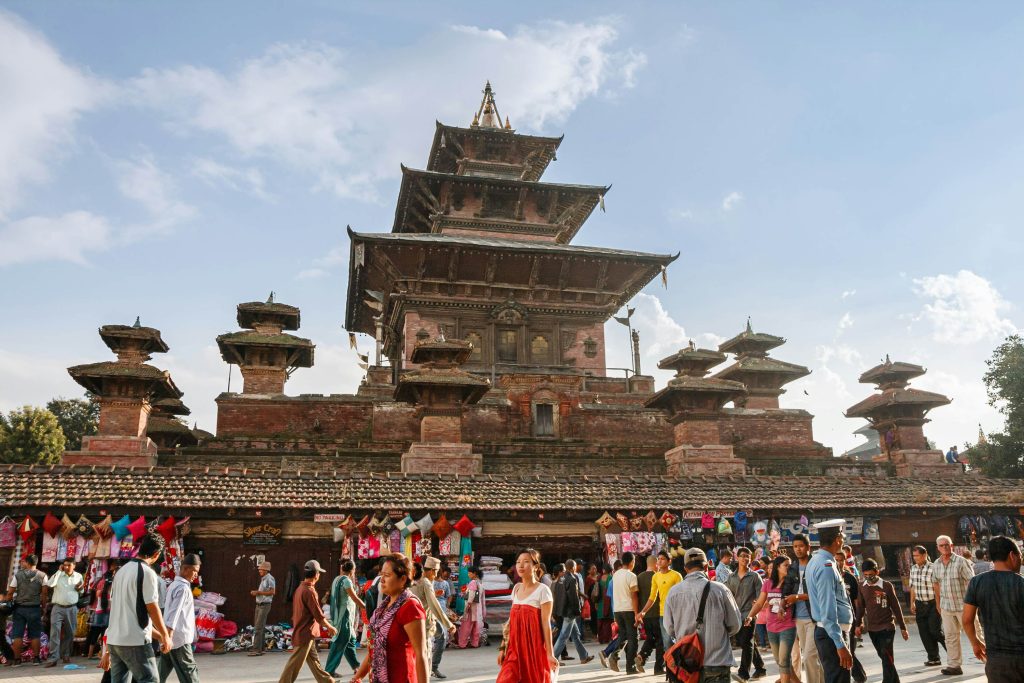
– Maru Tole: A historic square located near Kathmandu Durbar Square, Maru Tole is surrounded by traditional Newari houses and temples. This area offers a glimpse into the daily life of Kathmandu’s historic community and features architectural styles that date back several centuries.
– Swet Bhairab:This temple is dedicated to Seto Bhairab, a fierce manifestation of Lord Shiva. The temple is known for its unique architectural features and the large stone statue of the deity, which is adorned with offerings and surrounded by vibrant rituals. It represents the deeply rooted Hindu traditions of the valley.
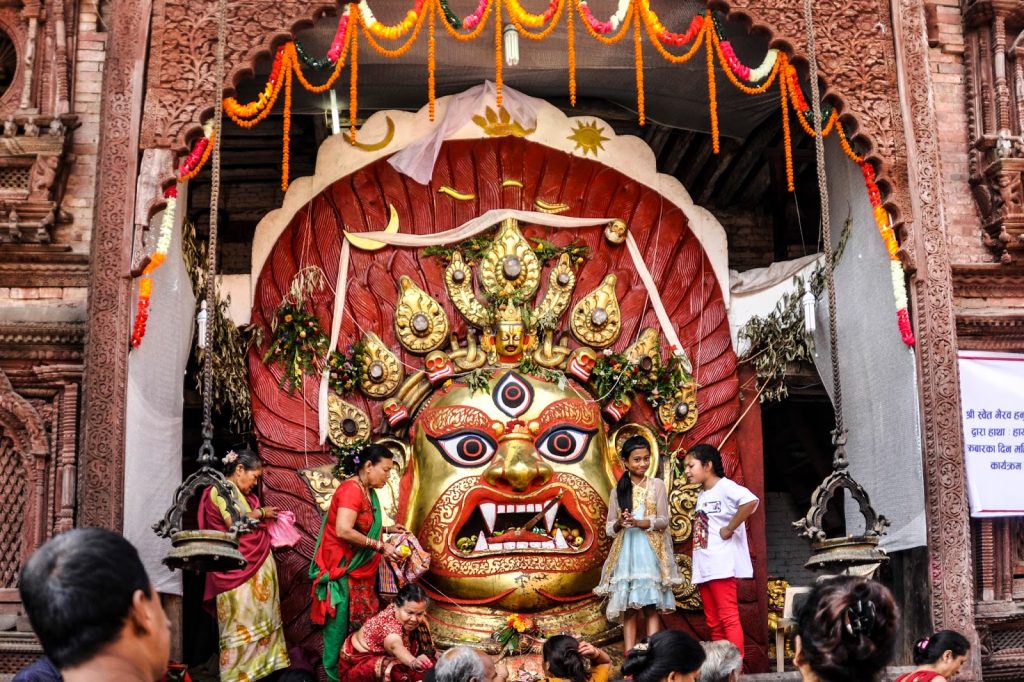
Visitor Information
– Entry Fee:
– SAARC Nationals: NPR 150
– Other Tourists: NPR 1000
– Opening Hours: The square is typically open from 9:00 AM to 5:00 PM daily. However, hours may vary during festivals, special events, or due to local conditions.
Getting There:
– From Thamel: A 15-20 minute walk through bustling streets like Ason and Indra Chowk, which provides an opportunity to experience the local market atmosphere. Alternatively, a taxi ride offers a quicker and more convenient option.
– By Taxi: Easily accessible from major areas in Kathmandu, with taxis widely available throughout the city.
– Tips for Visitors:
Dress Code: Dress modestly to respect local customs and religious practices.
Security: Keep an eye on your belongings, as crowded areas may attract pickpockets.
Local Guides: Hiring a local guide can greatly enhance your experience, providing detailed historical context and cultural insights.
Respect for Traditions: Be mindful of the local customs and practices, especially when visiting religious sites.
Bhaktapur Durbar Square: A Medieval Masterpiece
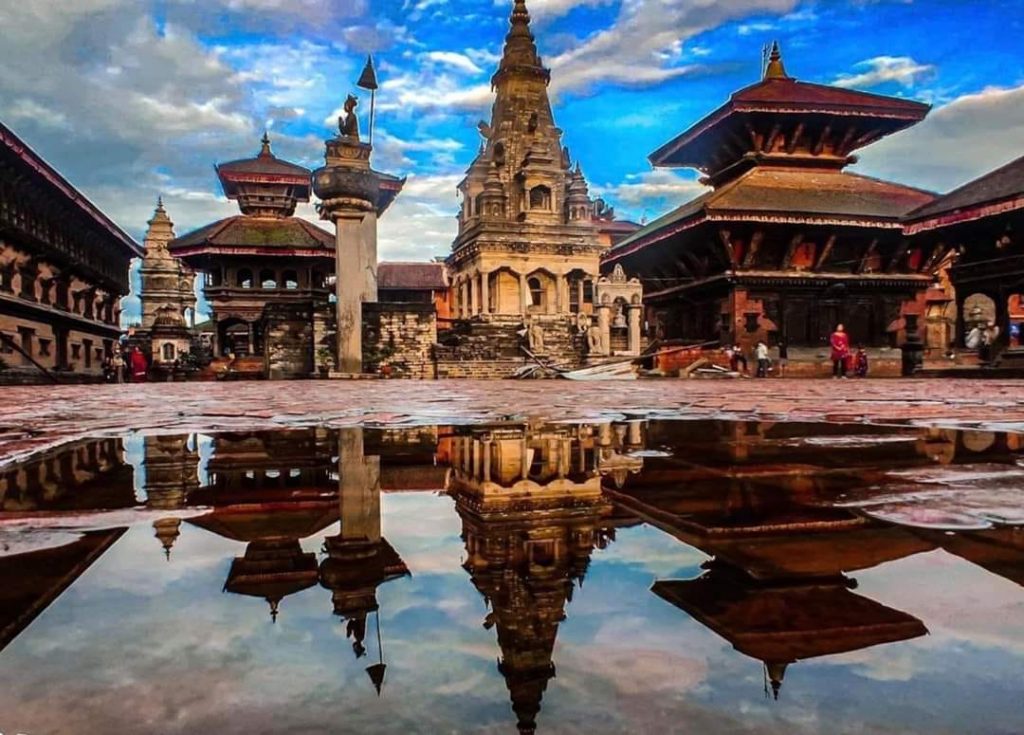
Overview
Bhaktapur Durbar Square, a UNESCO World Heritage Site, is celebrated for its well-preserved medieval architecture and vibrant Newari culture. It serves as a showcase of traditional craftsmanship, from intricately carved temples to bustling artisan quarters.
Historical Significance
Bhaktapur Durbar Square was once the royal palace complex of the Malla kings who ruled the Kathmandu Valley from the 12th to the 15th centuries. The square was a center of political, cultural, and religious life, with its architecture reflecting the grandeur of the Malla era. It remains a living testament to the artistic and architectural achievements of the Newar civilization, preserving the traditional essence of medieval Nepalese urban life.
Key Highlights
– Nyatapola Temple: Known as the tallest pagoda-style temple in the Kathmandu Valley, Nyatapola Temple stands out for its impressive height and intricate design, symbolizing the architectural prowess of the Malla period.
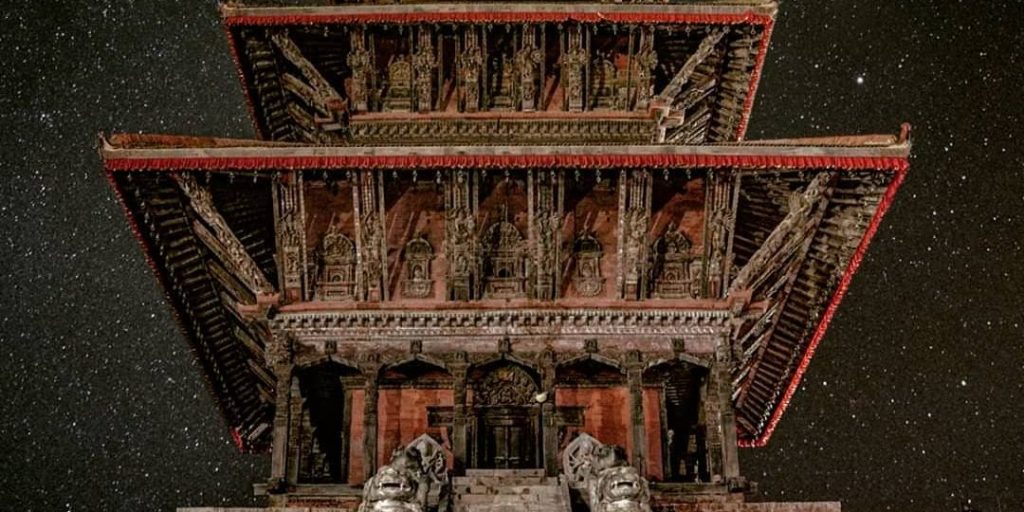
– Palace of 55 Windows: This historic royal palace is renowned for its ornate wooden windows and detailed carvings, reflecting the sophistication of Newari craftsmanship and the opulence of the Malla kings’ court.
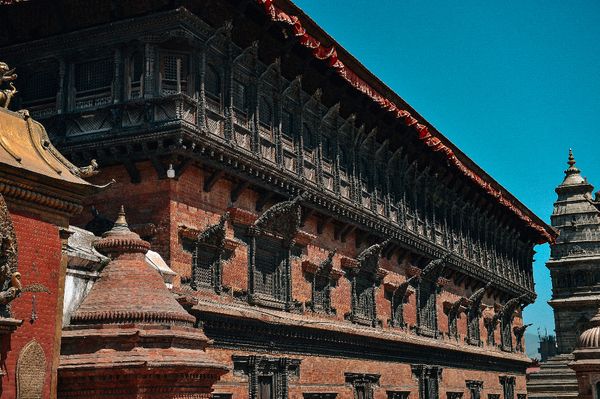
– Pottery Square: A lively area where traditional Newari pottery is crafted and sold, showcasing Bhaktapur’s rich craft heritage and offering a glimpse into the daily life of its artisans.
Visitor Information
– Entry Fee:
– SAARC Nationals: NPR 500
– Other Tourists: NPR 1500
– Opening Hours: Generally open from 9:00 AM to 5:00 PM daily. Check locally for any updates or changes.
– Getting There:
– From Thamel: A 45-minute taxi ride or a local bus from Naya Bus Park provides an opportunity to experience local markets along the way.
– Tips for Visitors:
– Wear Comfortable Shoes: The cobblestone streets can be uneven.
– Respect Local Customs: Ask permission before taking photographs of people.
– Try Local Delicacies: Sample traditional Newari street food from local vendors.
Patan Durbar Square: A Hub of Newari Art and Architecture
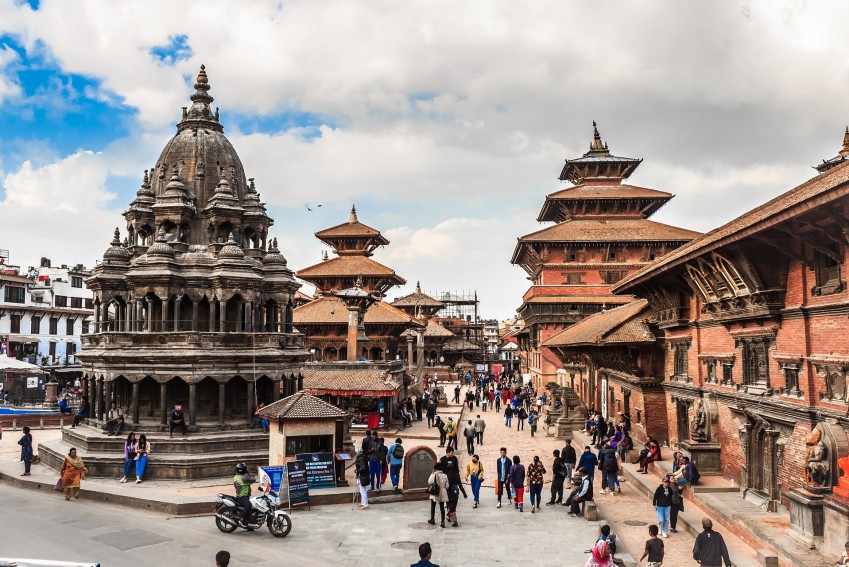
Overview
Patan Durbar Square, located in Lalitpur, is renowned for its stunning Newari architecture and the Patan Museum. The square is a treasure trove of ancient temples and intricate sculptures, reflecting the rich cultural heritage of Nepal.
Historical Significance
Patan Durbar Square was the royal palace complex of the Malla kings who ruled Lalitpur (Patan) from the 12th century. It was a crucial center for art, culture, and governance. The architecture of the square showcases the Newari style, characterized by elaborate carvings and pagoda temples. The Patan Museum, housed in a former royal palace, was established to preserve and display the artistic legacy of the Malla era and beyond.
Key Highlights
– Krishna Temple: Renowned for its elaborate stone carvings and intricate details, the Krishna Temple exemplifies the artistic excellence of Newari architecture during the Malla period.
– Golden Temple: A Buddhist shrine adorned with gold leaf, reflecting the influence of Tibetan Buddhism in Nepal and showcasing the intricacy of traditional Buddhist art.
– Patan Museum: Situated in a restored royal palace, this museum offers a comprehensive collection of traditional Nepalese art and historical artifacts, highlighting the cultural richness of Patan.
Visitor Information
– Entry Fee:
– SAARC Nationals: NPR 250
– Other Tourists: NPR 1000
– Opening Hours: Typically open from 9:00 AM to 5:00 PM daily. Verify local sources for any changes.
– Getting There:
– From Thamel: A 20-minute taxi ride or a public bus from Ratna Park provides a convenient and straightforward route.
– Tips for Visitors:
– Explore the Alleys: Discover hidden gems in the small streets around the square.
– Engage with Local Artisans: Learn about traditional crafts and techniques.
– Enjoy Local Cuisine: Sample Newari dishes at nearby restaurants.
Changu Narayan Temple: An Ancient Sanctuary
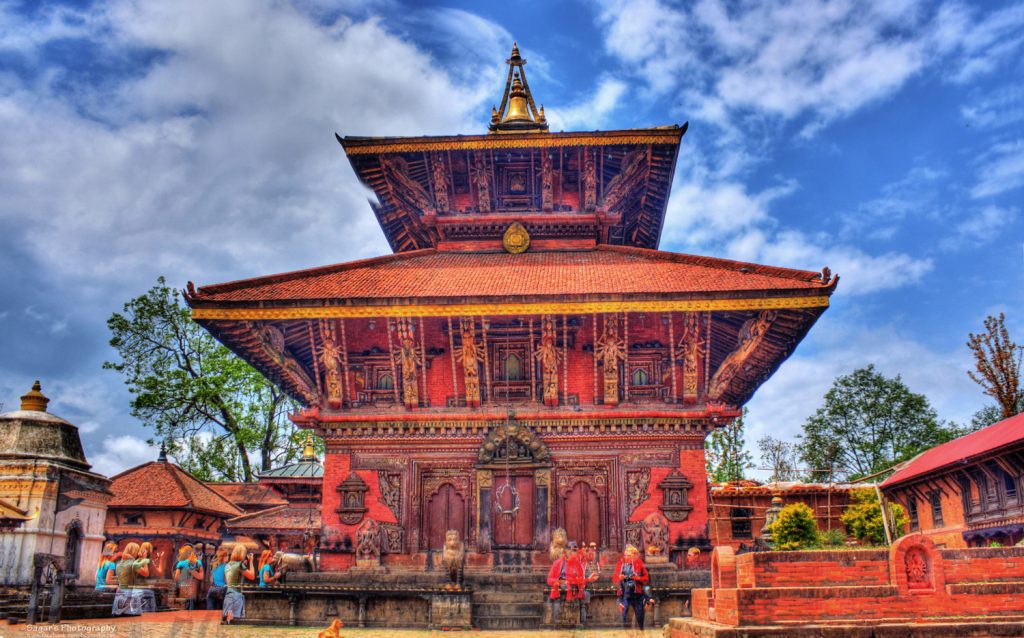
Overview
Changu Narayan Temple, one of Nepal’s oldest Hindu temples, is dedicated to Lord Vishnu. Perched on a hilltop, it offers serene surroundings and a glimpse into ancient Nepalese art and architecture.
Historical Significance
Built during the 4th century AD, Changu Narayan Temple is a crucial site for understanding early Hindu architecture and art in Nepal. It was originally constructed during the Lichchavi dynasty and represents one of the earliest examples of Hindu temple architecture in the Kathmandu Valley. The temple’s historical significance is further highlighted by its intricate carvings and inscriptions, which provide insight into the religious and artistic developments of the time.
Key Highlights
– Stone Sculptures: The temple features various avatars of Lord Vishnu, with sculptures dating back to the Lichchavi era. These carvings are notable for their artistic and historical significance.
– Changu Museum: Displays ancient carvings and artifacts related to the temple’s history, offering context to its historical and cultural importance.
Visitor Information
– Entry Fee:
– SAARC Nationals: NPR 100
– Other Tourists: NPR 300
– Opening Hours: Typically open from 9:00 AM to 5:00 PM daily. Check for specific hours locally.
– Getting There:
– From Bhaktapur: Accessible by public bus followed by a short hike or a taxi ride.
– Tips for Visitors:
– Respect Local Customs: Adhere to religious practices and dress modestly.
– Enjoy the Views: Take in panoramic views of the Kathmandu Valley from the temple.
– Wear Comfortable Shoes: Prepare for a walk up the hill.
Swoyambhunath Stupa (Monkey Temple): A Spiritual Escape
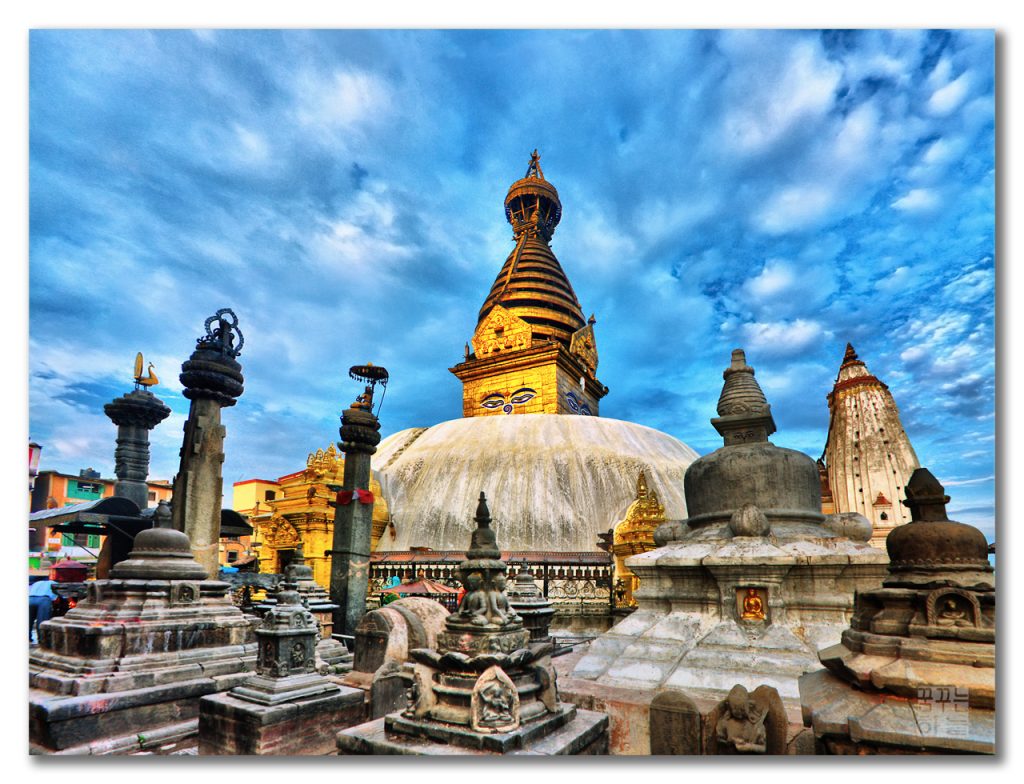
Overview
Swoyambhunath Stupa, commonly known as the Monkey Temple, is a major Buddhist pilgrimage site offering stunning views of Kathmandu. It is renowned for its large stupa and the lively monkeys that inhabit the area.
Historical Significance
Swoyambhunath Stupa, believed to be over 2,000 years old, is one of the oldest and most revered Buddhist sites in Nepal. The stupa’s origins are linked to the early Buddhist period, and it is considered a significant symbol of the spread of Buddhism in the region. The site has been a center of Buddhist practice and scholarship for centuries, reflecting its long-standing role in Kathmandu’s spiritual and cultural life.
Key Highlights
– The Stupa: Featuring Buddha’s eyes and colorful prayer flags, the stupa symbolizes enlightenment and spiritual wisdom.
– Viewpoint: Offers a breathtaking panoramic view of Kathmandu Valley, ideal for photography and contemplation.
Visitor Information
– Entry Fee:
– SAARC Nationals: NPR 50
– Other Tourists: NPR 200
– Opening Hours: Open daily from 7:00 AM to 6:00 PM. Confirm locally for any changes.
– Getting There:
– From Thamel: A 35-minute walk or a taxi ride. Public buses from Sorakhutte require a short hike.
– Tips for Visitors:
– Be Cautious of Monkeys: Avoid feeding them and keep your belongings secure.
– Bring Essentials: Carry a hat, water, and wear comfortable clothing for the climb.
– Visit Early: Arrive early to avoid crowds and enjoy a peaceful experience.
Boudhanath Stupa: A Symbol of Buddhist Harmony
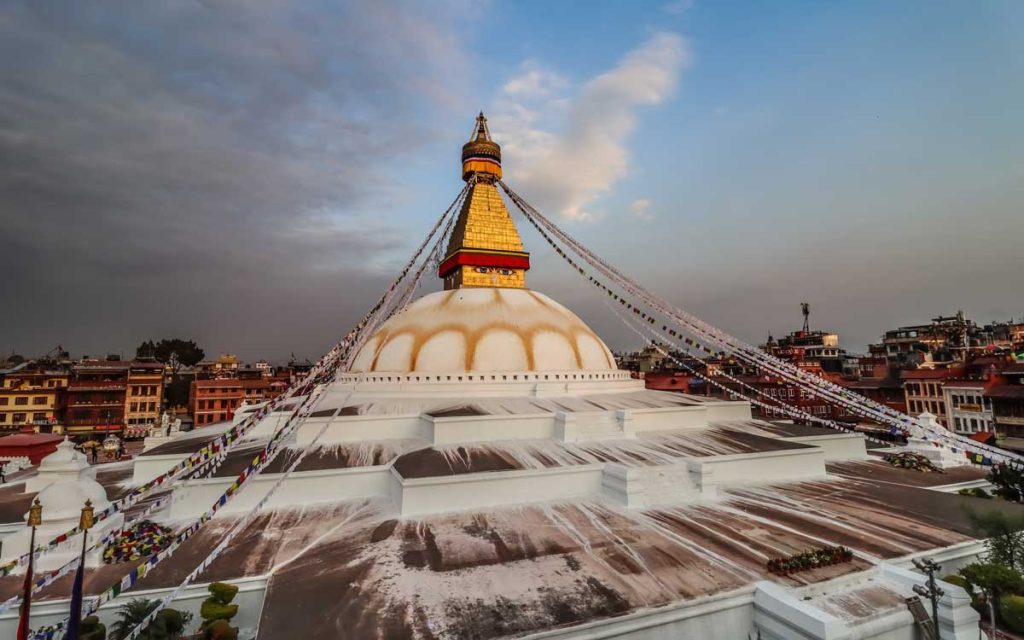
Overview
Boudhanath Stupa is one of the largest and most significant Buddhist stupas in the world. Its grand dome and all-seeing eyes are central to Tibetan Buddhism in Nepal, symbolizing peace and enlightenment.
Historical Significance
Boudhanath Stupa, dating back to the 5th century AD, is a major center for Tibetan Buddhism and a key pilgrimage site. The stupa’s massive dome and distinctive architectural style reflect the influence of Tibetan Buddhism on Nepalese religious practices. The stupa has been a focal point for Buddhist worship and meditation, embodying the spiritual harmony and unity of the Buddhist tradition.
Key Highlights
– Mandala: A large, symbolic design at the base of the stupa, representing the universe and enhancing spiritual understanding.
– Surrounding Monasteries: Explore various Tibetan monasteries and cafes around the stupa, offering insights into Tibetan Buddhist practices.
Visitor Information
– Entry Fee:
– SAARC Nationals: NPR 100
– Other Tourists: NPR 400
– Opening Hours: Open daily from 6:00 AM to 7:00 PM. Confirm specific hours locally.
– Getting There:
– From Thamel: Easily accessible by taxi or public bus from Ratna Park, Sundhara, and Gongabu.
– Tips for Visitors:
– Spin the Prayer Wheels: Walk clockwise around the stupa and spin the prayer wheels.
– Visit at Sunset: Enjoy a tranquil experience and beautiful views during sunset.
– Dress Respectfully: Ensure shoulders are covered and attire is respectful of local customs.
Pashupatinath Temple: A Sacred Hindu Pilgrimage Site
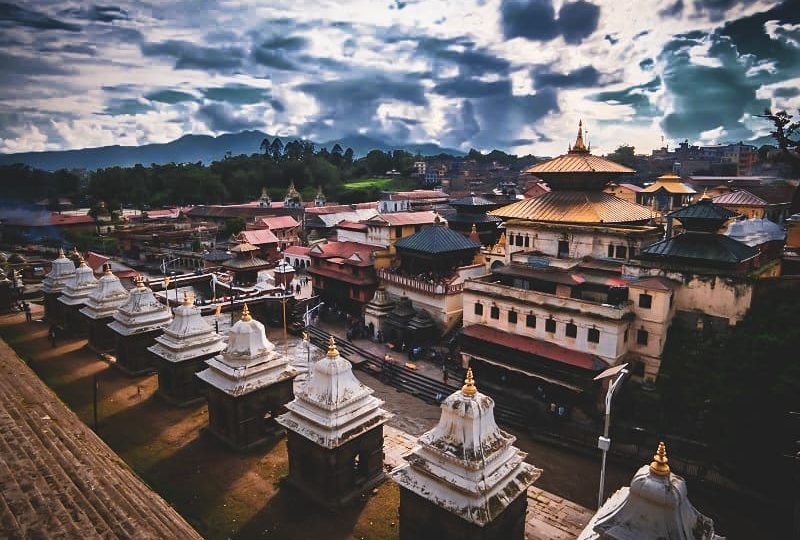
Overview
Pashupatinath Temple is one of the holiest Hindu temples dedicated to Lord Shiva. It is an important pilgrimage site known for its elaborate ceremonies and rituals along the Bagmati River.
Historical Significance
Pashupatinath Temple, believed to have been established in the 5th century AD, is a major center of Hindu worship and a key pilgrimage destination in Nepal. The temple’s architecture and rituals reflect its deep historical roots and its significance in the religious and cultural life of the Hindu community. The site has been a continuous center for Shiva worship, highlighting the enduring legacy of Hindu religious practices.
Key Highlights
– Arya Ghat: Observe traditional Hindu cremation rituals along the riverbank, providing a profound insight into Hindu customs related to death and the afterlife.
– Evening Aarti: A vibrant and elaborate ritual performed daily, featuring music, fire offerings, and a lively atmosphere.
Visitor Information
– Entry Fee:
– Indian Citizens: Free
– Other Tourists: NPR 1000
– Opening Hours: Open 24 hours, though visiting during daylight hours or for the evening aarti is recommended.
– Getting There:
– From Thamel: A short taxi ride or local bus. Conveniently located near Tribhuvan International Airport.
– Tips for Visitors:
– Dress Modestly: Remove shoes before entering the temple complex and dress respectfully.
– Respect Religious Practices: Be mindful of the customs and rituals observed.
– Engage with Guides: Local guides can offer deeper insights into the temple’s significance and rituals.
Lumbini: The Birthplace of Buddha

Overview
Lumbini is the revered birthplace of Lord Buddha and a major pilgrimage site. The area features sacred gardens, the Maya Devi Temple, and numerous monasteries from different Buddhist traditions.
Historical Significance
Lumbini is one of the most important sites in Buddhism, as it is believed to be the birthplace of Siddhartha Gautama, who later became the Buddha. The site dates back to the 6th century BC and is a crucial location for understanding the origins of Buddhism. The Ashoka Pillar, erected by Emperor Ashoka in the 3rd century BC, commemorates Buddha’s birth and underscores the historical significance of Lumbini in the spread of Buddhism.
Key Highlights
– Maya Devi Temple: Marks the sacred site of Buddha’s birth, featuring ancient ruins and the sacred garden.
– Ashoka Pillar: An ancient pillar commemorating Buddha’s birth, highlighting the significance of Lumbini in Buddhist history.
– World Peace Pagoda: A symbol of global harmony and peace, reflecting the universal values of Buddhism.
Visitor Information
– Entry Fee:
– SAARC Nationals: NPR 100
– Other Tourists: NPR 200
– Opening Hours: Open daily from 6:00 AM to 6:00 PM. Confirm specific hours locally.
– Getting There:
– From Kathmandu: An 8-9 hour drive or a 35-minute flight to Bhairahawa, followed by a short drive to Lumbini.
– Tips for Visitors:
– Respect the Serenity: Maintain the tranquil environment of the sacred site and adhere to local customs.
– Hire a Guide: Enhance your visit with insights into the historical and spiritual significance of Lumbini.
– Visit Early or Late: To avoid crowds and enjoy a more peaceful experience.
Chitwan National Park: A Wildlife Adventure
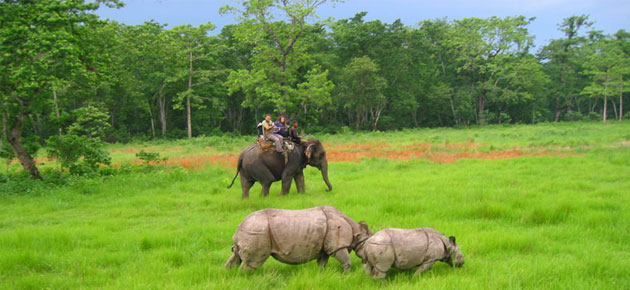
Overview
Chitwan National Park, a UNESCO World Heritage Site, offers a rich wildlife experience with opportunities to spot endangered species like the one-horned rhinoceros and the Royal Bengal tiger. The park features diverse safari options and immersive nature activities.
Historical Significance
Established in 1973, Chitwan National Park was Nepal’s first national park and played a crucial role in wildlife conservation efforts. It has been instrumental in protecting the habitat of the endangered one-horned rhinoceros and Royal Bengal tiger. The park’s establishment marked a significant step in Nepal’s commitment to preserving its natural heritage and promoting sustainable tourism.
Key Highlights
– Jeep Safari: Explore the park’s diverse ecosystems and wildlife, providing opportunities for spotting rare animals and enjoying the natural beauty.
– Tharu Village: Experience the traditional lifestyle of the Tharu people, including their customs, architecture, and cultural practices.
– Canoe Ride: Enjoy a peaceful ride on the Rapti River, offering a chance to observe wildlife such as crocodiles and various bird species.
Visitor Information
– Entry Fee:
– SAARC Nationals: NPR 1000
– Other Tourists: NPR 2000
– Opening Hours: The park is open daily from sunrise to sunset. Check for any seasonal variations.
– Getting There: – From Kathmandu: A 5-6 hour bus ride or a 20-minute flight to Bharatpur, followed by a short drive.
– Tips for Visitors:
– Bring Binoculars and a Camera: For optimal wildlife observation and photography.
– Wear Comfortable Clothing: Dress appropriately for outdoor activities and use insect repellent.
– Follow Park Rules: Adhere to guidelines and follow your guide for a safe and respectful wildlife experience.
Sagarmatha National Park: Trekking to the Top of the World
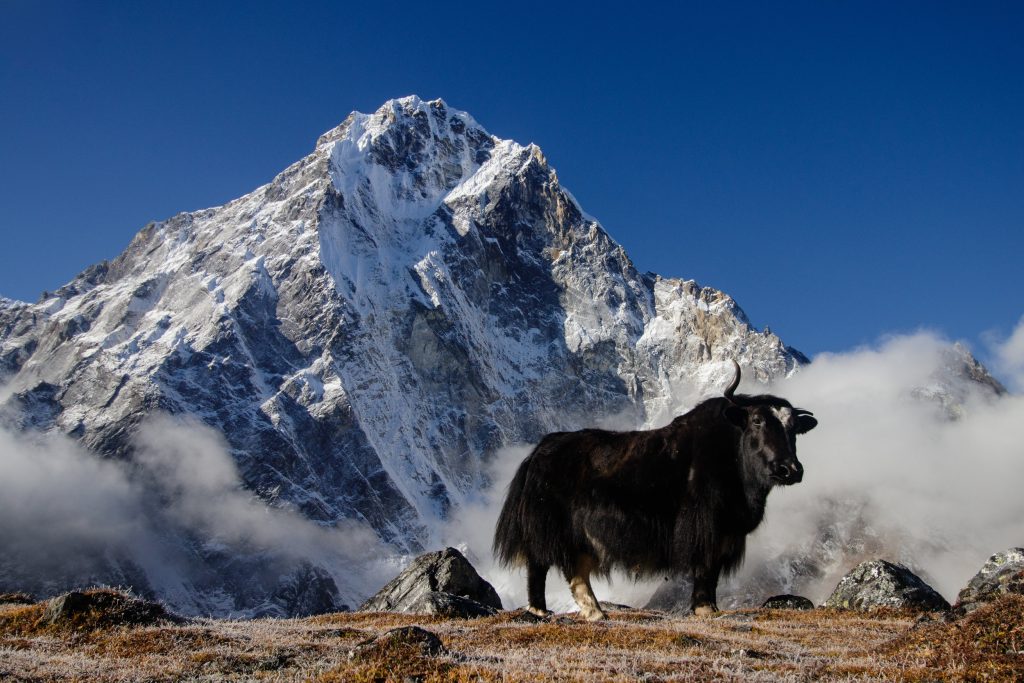
Overview
Sagarmatha National Park is renowned for its high-altitude landscapes and the towering Mount Everest. It is a prime destination for trekking and exploring the Himalayan ecosystem and Sherpa culture.
Historical Significance
Sagarmatha National Park was established in 1976 and covers the area surrounding Mount Everest, the world’s highest peak. The park is not only a natural wonder but also a cultural treasure, as it is home to the Sherpa people, whose lives and traditions are deeply intertwined with the Himalayas. The park plays a vital role in the preservation of this unique mountain ecosystem and the cultural heritage of the region.
Key Highlights
– Mount Everest: The world’s highest peak, offering breathtaking views and challenging climbs for trekkers seeking adventure.
– Gokyo Lakes: A stunning system of high-altitude freshwater lakes, providing serene environments and spectacular vistas.
– Sherpa Villages: Experience the rich culture, traditions, and hospitality of the Sherpa people in their traditional villages.
Visitor Information
– Entry Fee:
– SAARC Nationals: NPR 1500
– Other Tourists: NPR 4000
– Opening Hours: Open year-round, although trekking conditions vary by season. Check for specific trail updates and conditions.
– Getting There:
– From Kathmandu: Fly to Lukla or trek from Jiri for a longer journey.
– Tips for Visitors:
– Prepare for High Altitude: Equip yourself with proper gear and acclimatize appropriately.
– Respect Local Customs: Engage with Sherpa guides to gain deeper insights into their culture.
– Carry Sufficient Cash: Ensure you have enough cash and necessary permits for the trek.
Conclusion
Nepal’s UNESCO World Heritage Sites are a testament to the country’s rich cultural and natural legacy. From the ancient temples and palaces of Kathmandu Valley—such as Kathmandu Durbar Square, Bhaktapur Durbar Square, and Patan Durbar Square—to the spiritual serenity of Lumbini, the birthplace of Buddha, these sites offer profound historical insights.
Chitwan National Park and Sagarmatha National Park showcase Nepal’s commitment to conservation, with opportunities to see endangered wildlife and the world’s highest peak, Mount Everest. Each site not only reveals Nepal’s diverse heritage but also highlights ongoing efforts to preserve these treasures.
Visiting these sites provides a deeper understanding of Nepal’s historical, cultural, and ecological significance, making them essential stops for anyone looking to fully experience the country’s enduring wonders.

